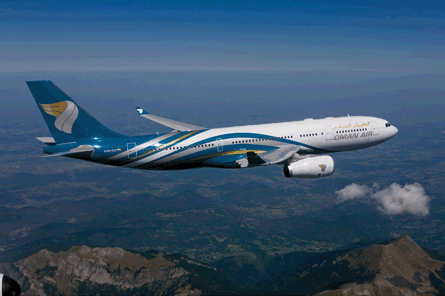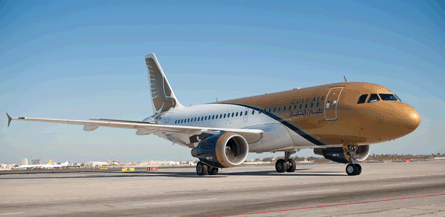One place where the fall-out from the Gulf's airline boom has been felt more than any other is at the home of the region's original network carrier, Gulf Air. Once the Gulf's primary international airline with hubs across the region, Gulf Air has retrenched into its Bahrain base as each of its other shareholders - Abu Dhabi, Oman and Qatar - pulled out one by one.
The airline, which carried just under six million passengers in 2008, has undergone a series of management shake-ups in recent years, the latest occurring in the summer, when former Royal Jordanian boss Samer Majali took over. Before his departure, Majali's predecessor, Björn Naf, had set about rebuilding the loss-making airline with the bold mission statement "re-conquering the Gulf".
 |
|---|
© Oman Air |
This had seen Gulf Air initiating a fleet-renewal effort by signing orders with Airbus and Boeing for a raft of new A320s, A330s and 787s, the first of which, an A320, arrived in September.
The airline serves 43 destinations in 28 countries with a fleet of 36 aircraft, and has a further 35 on order. Gulf Air is reluctant to talk while Majali is taking stock ahead of plotting the next move. This involves a comprehensive review, with Majali having warned the airline's employees in August that the carrier cannot continue to operate propped up by government subsidies.
Oman, which was the most recent ex-Gulf Air shareholder to cut itself free, is midway through a rebuilding process of its national carrier that will see it operating as a niche player but with a growing international network.
"When the decision was taken to part company at the end of 2007, the Oman government decided to transfer the investment it had been making in Gulf Air to Oman Air," says Peter Hill, who was appointed as Oman Air chief executive in mid-2008. "It bought out the existing private investors and set about transforming the airline."
Hill, who was previously head of Sri Lankan Airlines (and was a long-term Emirates executive), has been overseeing the rebuilding and expansion of Oman Air's capability from a regional player into a fully fledged international carrier serving points in Europe, the Far East and further afield in Africa. It now flies to 26 destinations and more will come on line next year.
 |
|---|
© Gulf Air |
The backbone of the Muscat-based airline's operations is the Boeing 737-800, which grew by five aircraft to a fleet of 15 in 2009, while two ATR 42s serve its domestic network. This year Oman Air has introduced four widebody types in the form of Airbus A330-200/300s. Four have arrived during 2009 and three more will come in next year. The first of six Boeing 787s is due to arrive in 2014 - subject to any further programme delays.
Oman Air has undergone a huge increase in capacity this year with nine aircraft coming in. Hill says: "We've taken a 32% increase in available seat kilometres over the last 12 months, when most people have been going the other way."
This capacity and network growth will see passenger numbers rise from two million in 2008 to 2.5 million this year. Passenger numbers are expected to expand to around three million in 2010.
Oman Air is being developed to support the requirements of the country, says Hill, which is seeking to expand its leisure market as part of a mission to diversify its economy away from the petrochemical industry as the natural resources expire in the coming decades.
"Tourism is the biggest opportunity, but unlike Dubai, we don't have to man-make anything - Oman has 1,700km [1,050 miles] of coastline and beaches," says Hill.
The airline is targeting both inbound and outbound leisure traffic. Beyond the tourist sector Hill says there is a market within Oman and the Gulf to transport expatriate worker traffic. He adds, however, that the size of that market is not as big in Oman as in other Gulf countries because a larger proportion of the home population is employed. "For example, 68% of the airline's workforce are Omani - you won't find that in another Gulf carrier."
Hill says that Oman Air has been "relatively cushioned" from the economic downturn in many markets, as it does not have the same level of competition serving its Muscat hub, compared with other parts of the Gulf. Although Hill concedes that the airline "has taken a hit on yields", he says its positioning as a niche player has limited the impact.
The airline's focus on Oman's point-to-point business is evidenced by the fact that only 30% of traffic is in transit. Although fifth and sixth freedom traffic is not "totally ignored", Hill says it is "a secondary attraction for us. All our flights are designed for O&D traffic, with sensible times for arrival and departure."
There are opportunities, however, for some points in the network to be linked to Muscat as a two-centre holiday, and Hill cites the airline's newest destination, the Maldives, as an example.
While airline tie-ups are light on the ground at Oman Air - it has just one codeshare, with Emirates - Hill says this could expand. "We need a strong partner in three or four parts of our network to ensure we've got the feed we will need."
From a financial perspective, the airline is in the red, but Hill warns that it cannot stay this way. "We're not going to be a bottomless pit for the government to put money into. It expects a return on its investment at some stage, but this will not be tomorrow."
The airline lost about 40 million Rials ($100 million) and Hill does not foresee any improvement this year. "I'm targeting five years for the group to reach break-even," he says.
Source: Flight International























